The Surface 3 Review
by Brett Howse on May 4, 2015 9:00 AM ESTSystem Performance
Since the Surface 3 is a tablet that can replace your laptop, comparisons will be made between both devices. Because the new tablet is running full Windows 8.1 x64, it is possible to run the full benchmark suite that we have for laptops. On the tablet side, there are not a lot of cross-platform benchmarks so the only thing that can really be used is browser based tests. It is not ideal, but we have to work with what we have.
To summarize the Surface 3, it is powered by the top model of the latest Intel Atom 14nm stack. The Atom x7-Z8700 is a quad-core processor with a base frequency of 1.6 GHz. The CPU can turbo up to a maximum of 2.4 GHz, and all of this is done within a 2 watt Scenario Design Power. The review unit that I received is the $499 unit, so it only has 2 GB of LPDDR3 memory rather than the 4 GB offered on the higher priced model.
For comparisons against tablets, I have selected a sampling of several devices that have already been reviewed. Some of the devices are running on ARM processors, and several of the Windows ones run on Intel Core M, with a few more running on previous Atom architectures. To compare this device against any other device we have tested, please check out our Mobile Bench.
Tablet Performance
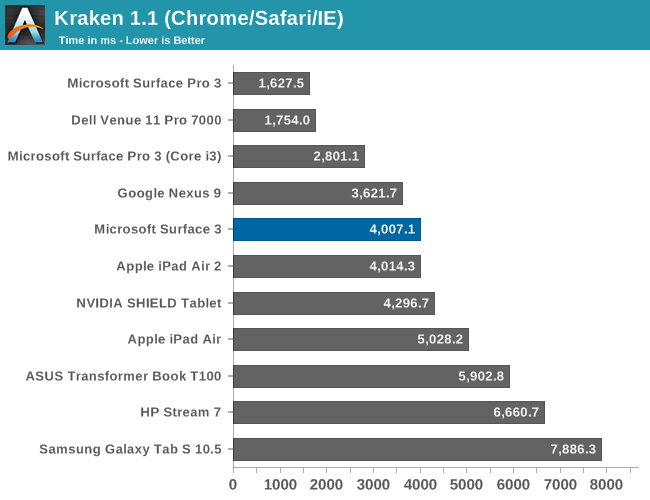
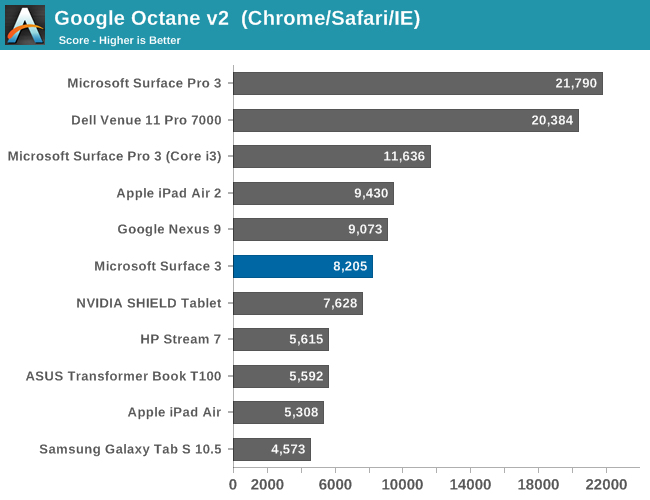

Since we just have web benchmarks to compare against other platforms, it does make it difficult to get a true feel for how Atom compares to the best, but when comparing to ARM processors it is fairly competitive. All of the web benchmarks are done using Chrome (hopefully we can switch to Microsoft Edge soon) because IE 11 has pretty awful javascript performance. Atom is a long ways off of the Core series in the Surface Pro line, and well back of the Core M powered Dell Venue 11 Pro tablet. There is a big jump in performance compared to the Bay Trail ASUS T100 and HP Stream 7. That is important since Cherry Trail is not a big architecture update, but mostly a process shrink, so the 14 nm processes can keep everything running at higher frequencies in the same power envelope.
Laptop Performance
By attaching the keyboard, the Surface 3 becomes a pretty reasonable laptop, so to see how much of a performance drop off there is with tablet class parts, the Surface 3 was run through our Laptop suite as well. The Atom is also equipped with eMMC storage, and some of the tests like PCMark take storage into account. Other benchmarks like Cinebench and x264 are CPU only. To compare the Surface 3 against any other laptop we have tested, please use our Laptop Bench.
PCMark

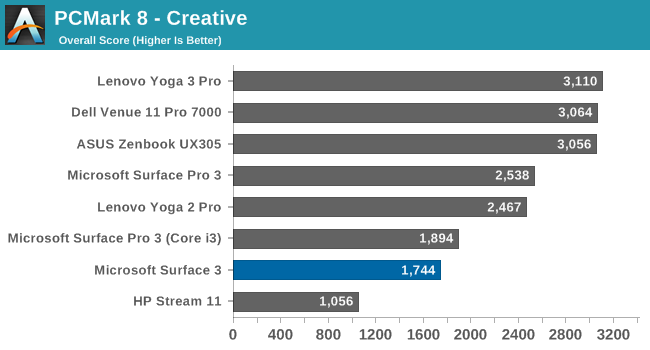
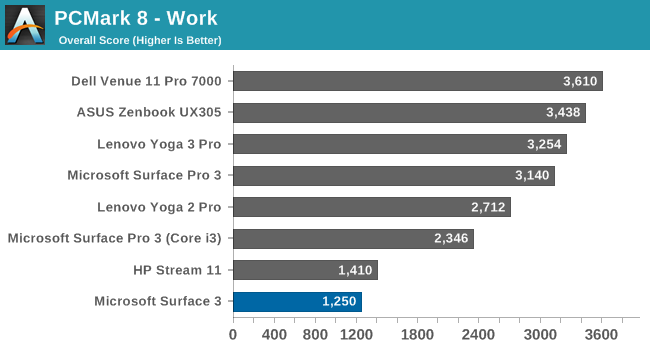
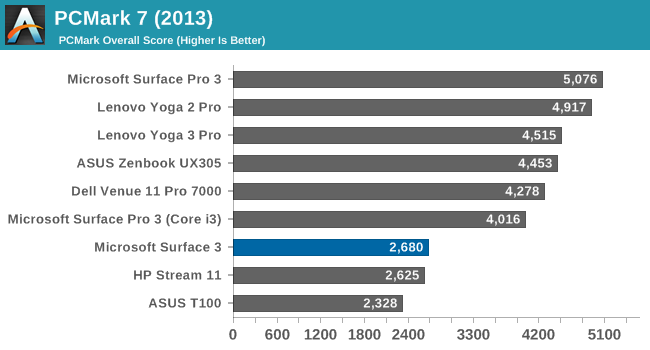
PCMark 8 from Futuremark has several benchmarks within it, all with the goal of simulating real-world use cases for each of the scenarios. It includes Home, Creative, Work, and Storage benchmarks. The workloads generally include both burst and sustained performance. The Atom can’t compete with the bigger Core pieces, but it is actually surprisingly close to the Core i3 Surface Pro 3. I think this is less about Atom and more about how handicapped Core i3 is with its lack of Turbo.
TouchXPRT


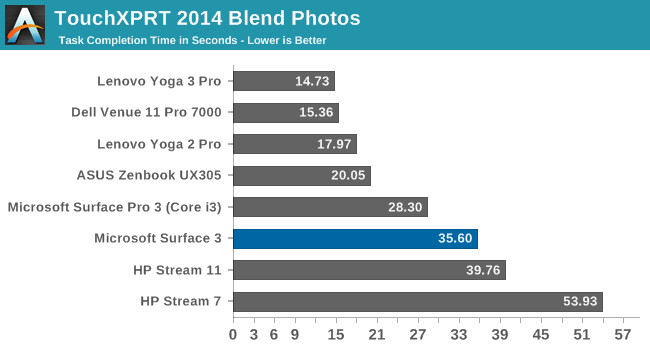
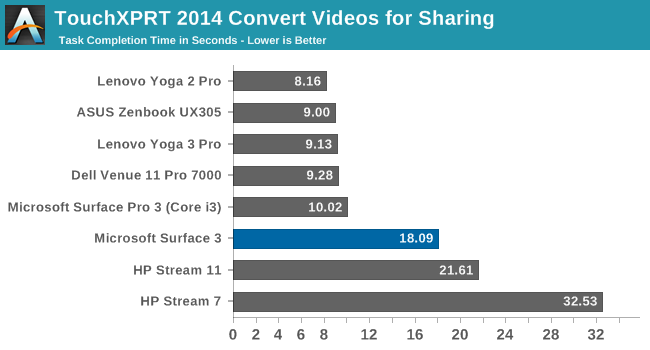
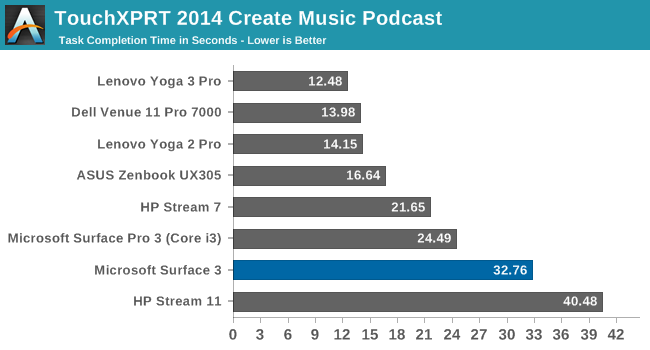
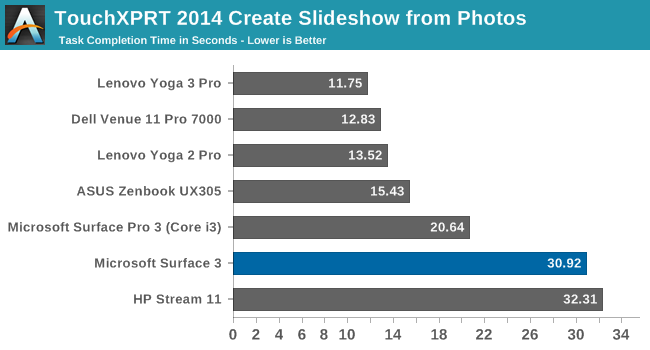
TouchXPRT 2014 is a benchmark that has a lot of burst workloads. The tasks are quick, but heavy, and it gives the processor a quick chance to cool off between each one so normally it is good about not running into throttling behaviour. The Atom processor is a long way off of the Core series here, with the exception of the i3 Surface Pro 3 which has no turbo capability. However there is a good bump in performance over the previous generation Atom in the HP Stream 7.
Cinebench

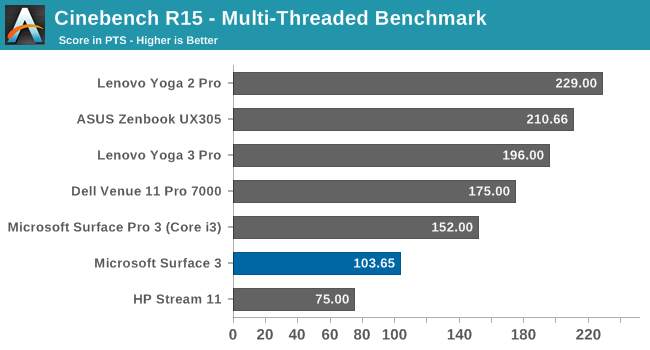
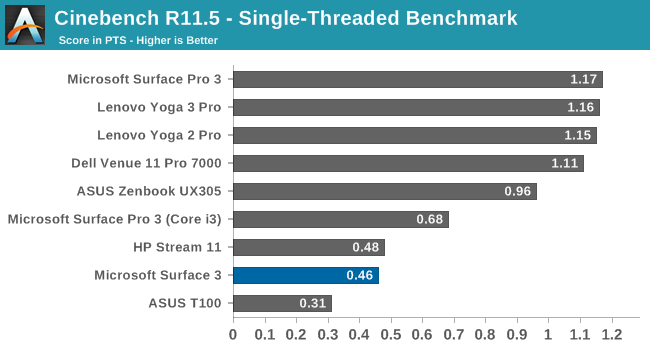
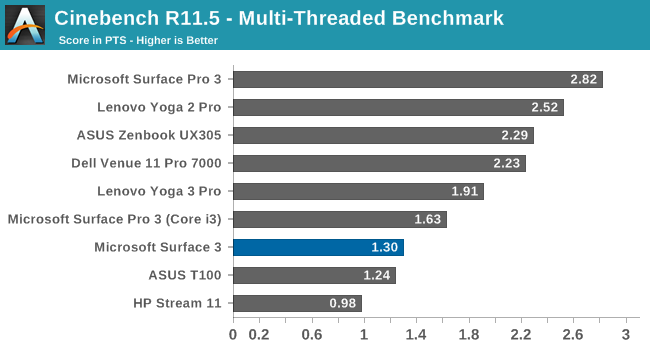
Cinebench is purely a CPU task, and it loves Instructions Per Clock (IPC) and frequency. There are two modes here with a single CPU run and all core run. It is still a long ways back of the Core i3 Surface Pro 3 on this test, and despite the Atom processor having four physical cores and the Core processors having only two physical and four logical cores, it is still not enough on the multithreaded run to really close the gap, although it does slightly. Looking at version 11.5 of this test, we have more data going back to older devices, so there are scores available from the ASUS T100 and there is a bump in performance compared to Bay Trail.
x264
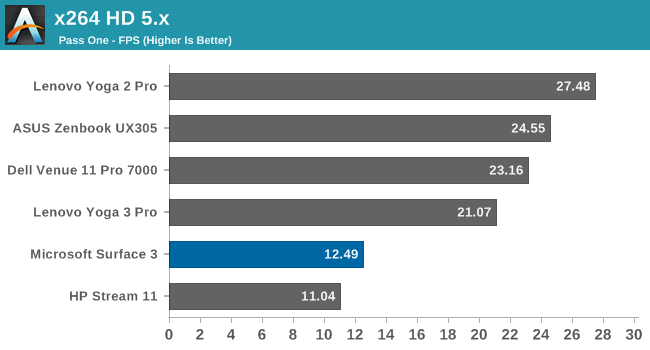

Once again this is a benchmark that prioritizes good IPC and frequency, along with multiple cores. The Atom struggles here compared to Core, which at this point should not be a surprise.
So clearly the new Cherry Trail CPU cores are not a giant leap in performance over Bay Trail, but like Haswell to Broadwell, there is a decent bump and the better manufacturing process helps increase overall performance due to the additional thermal headroom in the same power envelope. However when comparing it to the ARM competition, we only have a few data points but it does seem to be about on par with the top ARM CPUs at this time. Comparing devices across different operating systems is always difficult though.
Using the device day to day as a tablet though, performance was good. Yes, it could be better, and devices that use Core M are going to be able to run circles around Atom, but at the cost of additional heat. One of the nicest surprises of using this tablet was that it just never got warm at all, and the same cannot be said of any of the passively cooled Core M devices. Sure, when running very heavy benchmark loads, there was a bit of heat on the back, but it was never much more than around 30°C or so.
My experience was that when the Surface 3 felt slow, it was often not CPU bound but disk bound.










265 Comments
View All Comments
nikon133 - Monday, May 4, 2015 - link
Very inclined to finally replace my old ThinkPad Tablet 2 with Surface 3.Better battery life would be good, but close to 8 hours of tablet-mode browsing and video watching should do.
In addition, I love how kickstand works on SP3 and it's presence - even in simplified form - makes big difference for me. Looking at scores, this might even be able to handle some light Lightroom work - the most demanding task I have for my laptop at present - so it could fully integrate my tablet and laptop needs, leaving me with tablet and desktop only. One device less to update, charge, maintain, buy in a first place - sounds good to me.
Novacius - Monday, May 4, 2015 - link
In my opinion, it's too heavy compared to a iPad Air 2 or so. And it's too expensive: Its starts at 599€ in Germany, the Pro variant only costs 90€ more.damianrobertjones - Wednesday, May 6, 2015 - link
Then people moving from the Ipad 4 will be more than happy with the S3kyuu - Monday, May 4, 2015 - link
Thanks for the review, Brett. No more nagging from me. ;)The one thing I am missing is the Dolphin benchmark. Were you unable to run that?
As far as the S3 itself goes; while I cancelled my preorder for it, I only did so because I was able to get a good deal on a Core i5 SP3 on ebay. For the price, it's still a lot more capable than a comparably priced iPad, and I wouldn't have been sorry to have it. And iPads still don't have a built-in way to prop themselves up, which I consider an indispensable feature nowadays. I am disappointed that the storage is a bit on the slow side given that we have some pretty fast eMMC (not to mention UFS) nowadays. And the battery life results are a bit worrisome.
metayoshi - Monday, May 4, 2015 - link
Dolphin benchmark on this thing? Believe me when I say this, my old Core i7-860 couldn't run Dolphin that well, save for a very few select games, and it's one of the reasons I upgraded to a Core i7-4790K last September. The Atom x7-z8700 is nowhere near the performance of the Core i7-860, and much is closer to the Core 2 Duo SU-7300 that was in the Asus UL30Vt that I had around the same time I built my Core i7-860 in early 2010. There's no question, this thing will suck running the Dolphin benchmark.I'm actually getting a Surface 3 myself, but it's definitely not for running the Dolphin emulator.
NA1NSXR - Monday, May 4, 2015 - link
This was the tablet I was waiting for, except it isn't. The choice of Atom over Core M is unacceptable to me, so as hard it was to wait for an iPad-sized device to bring full Windows, I will have to pass.kyuu - Monday, May 4, 2015 - link
If this had Core M, the price would barely be less than a Surface Pro.damianrobertjones - Wednesday, May 6, 2015 - link
Core m? You do know that the Lenovo Yoga devices, with Core M, have a fan! You might as well just go for the Pro 3.zodiacfml - Tuesday, May 5, 2015 - link
Nice, but its kinda bit late considering laptops based on the Core M have been getting thinner and quite reasonable in cost especially the Asus.Or is it just pricing, for the price without the keyboard it is pricey even with the good display.
I can only see this good for business or work where a tablet is being used for business/company software.
meacupla - Tuesday, May 5, 2015 - link
There's really one big difference between microsoft and asus.Microsoft will replace your product with little questions if you are dissatisfied with it, or it's really broken.
Asus will take you on a wild goose chase, if they ever admit there is something wrong with their product.